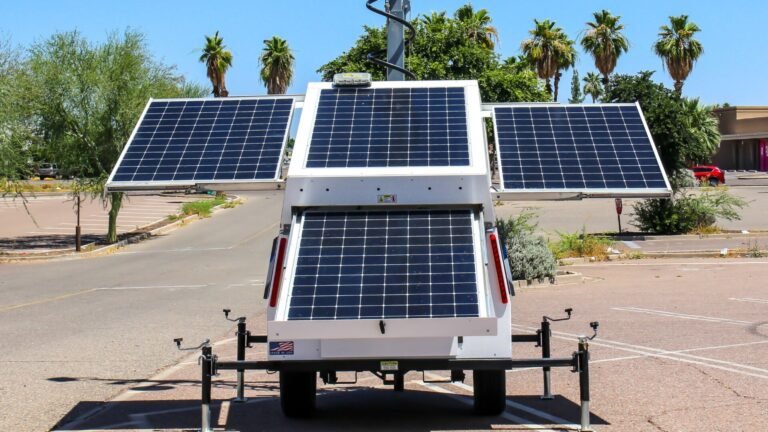As the world shifts towards renewable energy, solar-powered electric vehicles (EVs) are emerging as a revolutionary development in the automotive industry.
The integration of solar energy with electric vehicles promises a future where transportation is not only environmentally friendly but also more efficient and self-sufficient.
This blog explores how solar energy is transforming electric vehicles, the benefits of this innovation, and what the future holds for solar-powered electric vehicles.
We will delve into the technology behind solar-powered EVs, their potential impact on the environment, and the challenges that must be overcome to make this vision a reality.
The Evolution of Electric Vehicles
Electric vehicles have been gaining popularity over the last decade due to their reduced environmental impact and lower operating costs compared to traditional internal combustion engine vehicles.
Advances in battery technology, increased range, and the availability of charging infrastructure have made EVs a viable option for many consumers.
Additionally, government incentives and subsidies, along with growing awareness of climate change and environmental issues, have accelerated the adoption of electric vehicles.
Major automotive manufacturers are investing heavily in EV research and development, leading to a diverse array of models and options available on the market.
This rapid evolution signifies a pivotal shift in the automotive industry towards sustainable transportation.
The Role of Solar Energy in EVs
Solar energy offers a clean, renewable source of power that can significantly enhance the capabilities of electric vehicles.
Solar panels can be integrated into the design of EVs, allowing them to harness energy directly from the sun.
This concept of solar-powered electric vehicles has the potential to extend the driving range of EVs, reduce dependency on charging stations, and decrease overall energy costs.
How Solar-Powered Electric Vehicles Work
Solar-powered electric vehicles are equipped with photovoltaic (PV) cells, which convert sunlight into electrical energy.
These PV cells are typically installed on the roof and other exposed surfaces of the vehicle. The energy generated by the PV cells is then stored in the vehicle’s battery or used to power the motor directly, depending on the vehicle’s design and energy management system.
The efficiency of these PV cells is crucial to the performance of solar-powered electric vehicles. Recent advancements in solar technology have led to the development of more efficient, lightweight, and flexible solar panels, making them more suitable for automotive applications.
Innovations such as multi-junction cells and perovskite materials are further enhancing the efficiency and versatility of solar panels, allowing for greater energy capture and storage in varying light conditions.
Benefits of Solar-Powered Electric Vehicles
1. Extended Range
One of the most significant advantages of solar-powered electric vehicles is the potential to extend their driving range.
By continuously charging the battery with solar energy, EVs can travel longer distances without needing to stop at a charging station.
This extended range capability is especially beneficial for long-distance travel, reducing the frequency of stops and making solar-powered EVs a more convenient option for drivers who cover extensive distances regularly.
2. Reduced Charging Costs
Solar energy is free once the initial investment in solar panels is made. This can lead to substantial savings in charging costs over the lifetime of the vehicle.
Solar-powered electric vehicles can significantly reduce or even eliminate the need for grid electricity for charging.
As a result, owners can enjoy lower operational costs, contributing to the overall affordability of maintaining an electric vehicle, particularly in areas where electricity prices are high.
3. Lower Carbon Footprint
Electric vehicles are already known for their lower carbon emissions compared to conventional vehicles. By using solar energy, the carbon footprint of EVs can be further reduced, contributing to a cleaner environment and helping to combat climate change.
The use of solar energy eliminates the reliance on fossil fuels for electricity generation, ensuring that the energy used to power the vehicle is sustainable and environmentally friendly.
4. Energy Independence
Solar-powered electric vehicles offer a degree of energy independence. Owners can generate their own electricity, reducing their reliance on external energy sources and enhancing energy security.
This independence is particularly advantageous in remote areas or during power outages, where access to the grid may be limited or unreliable.
By harnessing solar power, vehicle owners can ensure a consistent and dependable energy supply.
Challenges and Considerations
While the benefits of solar-powered electric vehicles are clear, there are also challenges that need to be addressed:
1. Efficiency of Solar Panels
The efficiency of current solar panels is still relatively low, meaning that a significant amount of surface area is required to generate sufficient power.
This can be a limiting factor for vehicle design and aesthetics. Innovations in solar technology are essential to improving efficiency and making the integration of solar panels into vehicles more practical and visually appealing.
2. Energy Storage
Efficient energy storage solutions are necessary to store the solar energy generated. Current battery technology is continually improving, but there are still limitations in terms of capacity, weight, and cost.
Advances in battery materials and design will be crucial to enhance the storage capabilities of solar-powered electric vehicles, ensuring they can store enough energy for extended use without adding excessive weight or cost.
3. Weather Dependence
Solar-powered electric vehicles rely on sunlight, making them less effective in regions with limited sunshine or during extended periods of cloudy weather.
This variability can affect the reliability of solar power as a consistent energy source. To mitigate this challenge, hybrid systems that combine solar power with traditional grid charging can be employed, ensuring that vehicles have a reliable backup energy source when solar energy is insufficient.
4. Initial Costs
The integration of solar panels into electric vehicles can increase the initial cost of the vehicle. However, this can be offset by the savings in fuel and charging costs over time.
The long-term financial benefits, combined with the environmental advantages, make the initial investment in solar-powered electric vehicles a worthwhile consideration for many consumers and businesses.
The Future of Solar-Powered Electric Vehicles
The future of solar-powered electric vehicles looks promising as technology continues to advance. Research and development in both solar and battery technologies are paving the way for more efficient and cost-effective solutions.
Innovations such as lightweight, flexible solar panels and solid-state batteries could further enhance the viability of solar-powered EVs.
Several automakers and startups are already experimenting with solar-powered electric vehicles. For example, Lightyear, a Dutch startup, has developed a solar car that can travel up to 450 miles on a single charge, with a significant portion of that range provided by solar energy.
Similarly, major manufacturers like Tesla and Toyota are exploring the integration of solar panels into their EV models.
Conclusion
Solar-powered electric vehicles represent a significant step forward in the quest for sustainable transportation.
By harnessing the power of the sun, these vehicles offer a cleaner, more efficient, and potentially more cost-effective alternative to traditional electric vehicles.
As technology continues to evolve, solar-powered EVs are likely to become an increasingly common sight on our roads.
At Tamesol, we are committed to advancing solar technology and contributing to a sustainable future. Our cutting-edge solar solutions are designed to meet the growing demand for renewable energy and support the development of innovative technologies like solar-powered electric vehicles.
Together, we can drive towards a cleaner, greener future.





